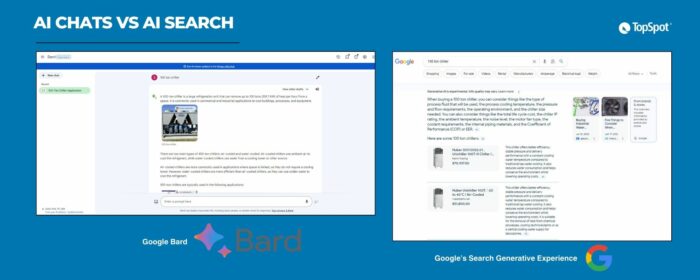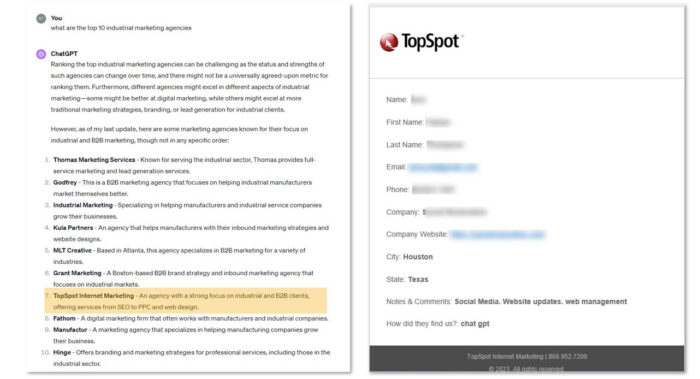November 21 2023
Navigating Digital Marketing in 2024 Part 1: Artificial Intelligence (AI) Observations and Predictions
What’s Next in Digital Marketing?
The year 2023 has been lively thanks to the rise of AI in search, an uptick in algorithm updates, and the rollout of Google Analytics 4. Digital marketing for next year is ramping up to be just as interesting with the continuing advancement of AI, more platform updates, and the uncertain future of Google as it faces an antitrust verdict. As marketers plan their 2024 digital marketing strategy, many turn to advice and trends to help prepare—a tall order considering the changes may continue into the holiday season.
In this series, Navigating Digital Marketing in 2024, we provide news and information to help your team plan ahead for variables that may affect your strategy. With changes still in progress, TopSpot looks to arm marketers and businesses with education to help with flexibility in digital marketing planning. In the first blog of the series, we focus on artificial intelligence (AI) news and observations, an area rapidly changing.

How is AI impacting the search landscape?
Prior to this year, AI was utilized by search engines only on the backend. Then major announcements saw AI enter the user interface. Microsoft led the charge with “the new Bing” powered by OpenAI and quickly opened the upgrade to all users on Microsoft Edge. A little later, Google introduced its options currently in beta called Google Search Labs. This feature above traditional search results is called SGE or search generative experiences. These search options came on the heels of AI chat applications ChatGPT, Google Bard, and Bing Chat (featured as a tab in its AI search experience).
The difference between AI chat and AI in search is that chats like ChatGPT and Bard look to create, converse, and collaborate by answering user input with human-like language to generate code snippets, foundations for writing, and definitional answers. These results do not include traditional link lists like search but conversational answers. Some like Bard and Bing include linked citations, while others like ChatGPT do not at this time. This leads to uncertainty in tracking traffic from these platforms. If citations are present, it could show up as referral. If they are not, it would show up as direct-to-site traffic.
AI in search like Bing and Google’s SGE looks to mimic the chat experience as well as aggregate content by finding information that helps answer questions or make purchases. It’s an upgrade of traditional search and provides a range of answers in a variety of formats including links and visuals. These will show in your analytics as organic results.
How will AI impact search in 2024?
When looking at AI in search in 2024, the first thing to note is Google’s SGE is expected to roll out to everyone next year. Initially, the experience dominated SERP results in beta, but as of October, a visible reduction was applied. Fears of SGE hurting PPC and SEO performance have abated with marketing professionals after this revision, with the hope that the feature is less likely to impact organic search traffic.
The traditional blue links list format began to be pushed down in 2014 after Google introduced Featured Snippets and Local Packs, so experts think SGE won’t disrupt traffic any more than these already have. However, as Google experiments with AI and SERP features with “zero-click” results, it’s more important for your content to populate these new features as well as the top links beneath—a place PPC can help.
As for chat applications, we are seeing a major shake-up currently with OpenAI, the company behind ChatGPT and the Bing experience. With one founder ousted and the other stepping down*, many at the company are not happy. Microsoft (home to Bing) scooped up the ousted founder and CEO, Sam Altman, so industry experts aren’t sure what this means in terms of AI chat’s future.
*Since this article published, both founders have returned to OpenAI. However, the shake-up’s ripple effects will be felt on its Board of Directors and in its operations.
How to Optimize Your Website Content for AI
AI offers you the opportunity to differentiate your business online by showing up in AI-based searches and chats, driving new business opportunities to your site. AI-based search engines and AI chats look at the same key features traditional search engines look for—everything is rooted in helpful content. That means optimizing for AI involves nearly identical steps to a standard SEO strategy, with content as the top focus.

TopSpot’s B-SMART® Method for content creation has proven effective in driving traffic and leads from both AI searches and chats. Its primary concern is user intent, how a potential customer will search, and the modifiers typed into a search engine or chat. It keeps in mind that users are search savvy and will use specifics like brand, shape, size, industry applications, requirements, and type. Without these specifics, the user will end up with irrelevant results featuring mega-retailers or companies with offerings not applicable to their industry.
The biggest difference in strategies is that AI applications are still in their discovery phase, meaning they are crawling pages for the first time. Page speed is critical here as faster pages means increased crawl efficiency, which leads to more pages crawled. Some AI tools (like Chat GPT) do not take in real-time data, but are updated manually with data uploads. Because of this, you may not show up in AI chat quickly after optimization compared to search. It is worth adding content that answers questions or research intent to show up later down the line.

Other tactics for AI optimization include meta tags (an HTML tag describing page content) and heading tags (an HTML tag that separates headings and subheadings from page content). Additionally, links, images, and URLs aligning with keyword and B-SMART strategies help these crawling bots locate your content.

How To Use AI for Content Generation
You may have heard in the news that educators are cracking down on essays and other schoolwork produced by AI. We’ve even seen resumes and job applications that have poorly utilized the tool. While embracing this technology will be important, using AI to do all the work is ill-advised—this goes for your SEO content too.
Search engines can detect AI-generated content and will depreciate the search value of this content over human-generated content. This effort has been central to Google’s updates, including its addition of another “E” to its “E-A-T” content guidance last year.
Marketers should consider using AI programs to generate content that aids in the early stages of creation to help with topics, outlines, and research. To do this, ask the application questions and utilize the tenets of B-SMART in order to get the keyword-powered answers your customers will be searching for. You can also use AI for the editing phase of content creation with tools like Grammarly to check spelling, grammar, and tone.
It is that crucial middle stage of content creation that should stay in human hands, ensuring that a business’ experience, expertise, authoritativeness, and trustworthiness are infused into the final product so that a search engine will reward it. Being featured like this will help a customer in their research. Content like testimonials, case studies, and product uses remain valuable to SEO success and use E-E-A-T and B-SMART methodologies.
AI Website Integrations for 2024
AI has been making waves on company websites beyond content for SEO, specifically with applications meant to enhance customer service, and is becoming especially popular in the e-commerce space. Chatbots for customer services and smart assistance along with product configurators top this list for 2024.
AI Chatbots: Companies are getting better customer service with AI assistive chatbots and smart customer service. These applications use AI and machine learning to answer basic customer questions and have over time become more conversational and less cumbersome. While these can’t replace service and sales reps with extensive knowledge, they can aid in the conversion process—offering fast answers and next steps to get your leads on the phone. These began increasing in use during the COVID-19 pandemic, and adoption is expected to rise.
AI Product Configurators: Applications like compatio.ai allow users to browse your products and configure a custom solution to meet their requirements. Their machine-learning capabilities can use multiple inputs to generate smarter recommendations. For areas offering a high level of customization, like industrial B2B, these technologies can help users find answers faster to convert quicker.
What’s Your Takeaway
Continuing a B-SMART strategy will aid your business in populating searches both traditional and AI. Additionally, companies that don’t have the budget for more expensive AI applications and integrations can still take part in the AI revolution with free tools.
As AI continues to grow, it’s important to remember that they are not meant to be job takers but job enhancers, meaning content creation and customer service are still essential to providing the best results for driving and closing quality leads.
Circle back soon to check out Part 2 of this series, Content Trends Impacting the Search Landscape and User Experience (UX). To learn more about improving SEO and optimizing for AI, contact your account team, or if you are not a TopSpot partner, contact the TopSpot Team.
Tags: AI, google, SEO
